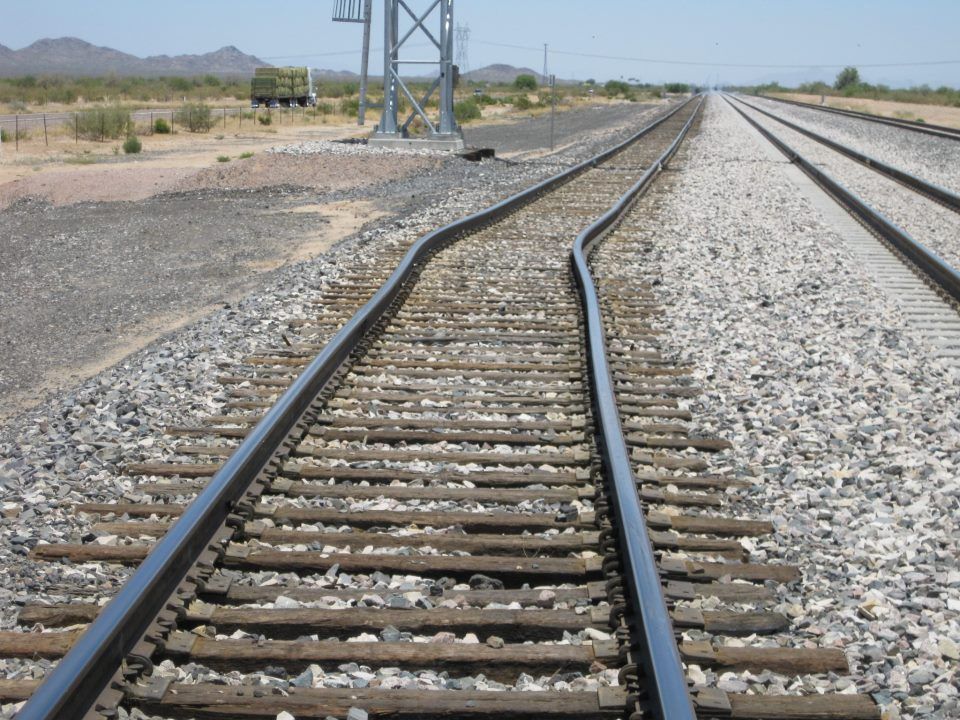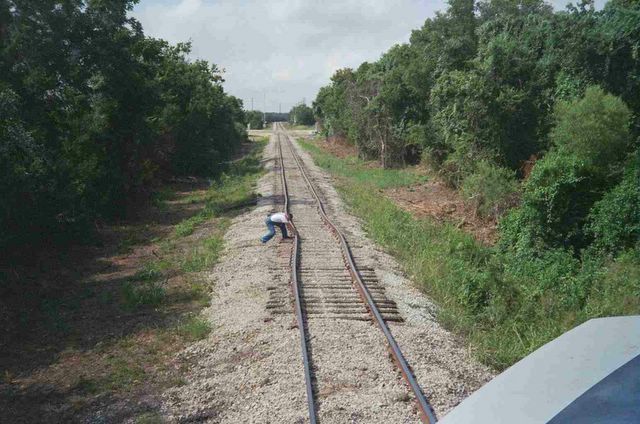Sun Kink MP 59.3 single track between Monument and Academy, CO in Tales of the Jointed Track
- Feb. 22, 2015, 7:40 a.m.
- |
- Public
We are single track now, Between Palmer Lake and Crews. This is CTC operation, mostly Rio Grande track owned till, mid siding, at Kelker, then was Santa Fe track from MP 659.9 (old Santa Fe) current MP 79.2 to Crews MP 654.4 (old Santa Fe) current MP 84.2 Per Negotiations, and with the BN and ATSF having the most haulage, the Santa Fe dispatched that CTC operation.
I had a coal load, same routine, helpers ran around the caboose, reattached it to the train. The rear end gave the okay to proceed, and away we went making the descent to the Springs. The train was balanced and handling well. We are lined through Monument. There is not a train there, for a meet, plus there are two more loads waiting to crest Palmer lake behind us.
High Green at the south end, blow for the crossing at Baptist Road. Another whistle for the private crossings around MP 58.8 and 58.9. There is a horse boarding and riding stable here. There are reverse curves thru here, ya can stall a bit, trim off the dynamic brake, let the cars shove ya thru the area.
MP 59.2
Came around the left hand curve, after the crossing. The track straightens for about 500-750 feet, the veers right. Well, there is a big curve, that is not normally there. What was it? A “sun kink”. To be politically correct, for the upper management, that did not appreciate “jargon” in the reports. A Thermal Mis-alignment”. GAG!!! really.
A few examples of a sun kink, or Thermal Misalignment. The top the track is well ballasted and maintained, but the heat of the day as moved the track. The second picture shown, looks like tie work was done, and the track gang cleared up, to let trains pass, under a slow order. The heat of the day caused it to buckle”.
The train was going about 22 mph stalling on the reverse curves, which is normal. Full dynamic brake and about a 10 lbs set off the brake pipe. Was handling very well.
I told the brakeman to hang on, I don’t think we’re gonna get over this. I set a full service, because emergency isn’t going to stop this, and will compound the problem. When we hit, the head unit went hard left the right then left again. We got past it and back on properly aligned and gauge track. Looking in the mirror, I could read the number board of the second and third units in the consist. The locomotives, all made it through, and the train is still coming over it. Ride it out, and wait for the emergency application, that will tell us they are piling up.
The caboose was called and were told of the sun kink and that we’re still going over it. The caboose stopped about 6 cars from the sun-kink. They walked up, and looked it over. The conductor says “I think we can get over this, only 6 cars”. I told ‘em ya better be ready to get on, because, the grade will start the acceleration. The head end was on a slightly level portion. I was going to wait it at least 9 mph and go make a big set. A mile down, Husted, ( or whats left of it) and the grade starts up for a quarter of a mile, levels off, then starts back down. I’ll stop ‘em there, and stall most of the train. That will give me a good recharge. The slack will come in, but we won’t take off, like a normal release at speed. I can hold ‘em here with 6 hand brakes, and maybe move 10 to 15 car lengths.
The dispatcher was called and notified about the problem. First question are you still on it? He was told the train is clear and we are ready to proceed. The trains behind us, and the one at Colorado Springs were not too happy with the radio report. The Rio Grande was notified, and upon inspection, they took the track out of service, to correct the condition. The crews behind us and the train at the Springs were tied down, and the crews taken to their respective terminals. They’d call relief crews, to co-ordinate with the completion time estimated for repairs.
It took the Rio Grande, with two section crews about 4 hours to correct. Luckily for them they had a Track tamper, and a Ballast regulator at the Stadium house track.
The stress on both sides were relived by chaining the rail, and taking a cutting torch and making a cut. The chain was released and the track allowed to run. We were told later, the east rail ran about 50 feet, and the west rail about 75 feet. A front end loader, with Hy-Rail equipment, was used to help pull the track into place. The tamper went over the crudely aligned track to adjust and straightened it out more. Two dump trucks, were used and filled with track ballast, from a storage pile at Husted. That and ties were there doing a replacement tie and curve rail relay project. The Dump trucks used the Right of Way road and the front end loaded spread the ballast into the area. While the trucks were on the way up, the section checked and replaced any missing spikes and rail anchors. The track was re gauged at this time, and checked with a gauging bar. The tamper went over it and tightened up the track. The ballast regulator finished off the area.
A ten mph slow order was placed over that portion of track. The Rio Grande would finish up the next morning. The track was monitored during the night.
Last updated January 30, 2017





ChallengerSeven ⋅ February 23, 2015
"...and the track allowed to run."
I'm not familiar with this term.
Thanks!
Brakeshoe Bob ChallengerSeven ⋅ February 23, 2015
The cut is made, to relieve tension.. it will move on it own. I have seen it. Its a crazy thing.
ChallengerSeven Brakeshoe Bob ⋅ February 24, 2015
Makes sense, but fifty or seventy-five feet! That's a lot of running!
(I wonder of there's a video of that...)
Thanks!
MageB ⋅ February 23, 2015
Wow...that's a scary thing to approach if you don't know it;s there.